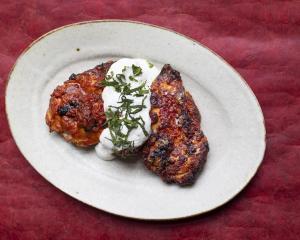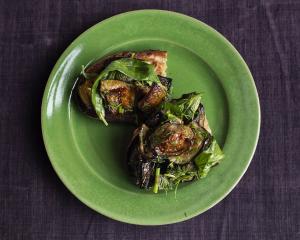Tamarillos, or tree tomatoes as they were once called, are a great example of yet another exotic fruit that New Zealand's horticulture industry has successfully relocated to our shores.
And like kiwifruit, tamarillos are now grown commercially and exported throughout the world.
Originally from South America, the fruit is roughly the size of a large egg and comes in several colours.
Red is the most common, but yellow and orange varieties are also available.
The plants themselves require a warm sunny spot to do well and need protection from frosts.
Like passionfruit, most of our national tamarillo crops are cultivated in the North Island where the climate is temperate.
However, they can also be grown successfully in hothouses further south and I'm pleased to say that the lone tamarillo tree looming above the herbs in our tunnel house will most likely bear fruit when it turns 2 next season.
A tip - if buying from your local supermarket seems a bit expensive, call in a favour from friends or relatives up north where tamarillos are prolific and get them to send you a box.
Aunty Jude, in Kamo, sends us 15kg (free, from her backyard) for $18, which sure beats the price we sometimes pay here.
Most of us tend to eat tamarillos fresh, sprinkled with just a little sugar, but their distinctive tart flavour also makes them perfect for use in baking, sauces, chutneys and drinks.
They can also be used to add flavour to casseroles and stews.
However, I like to keep things simple and let their unique taste stand out.
What better way to start a winter's day than with a satisfying bowl of hot porridge topped with sugared tamarillos?
A thick spicy tamarillo chutney is a great way of using up any leftover fruit and is particularly good with cold meats, especially roast pork.
Finally, an open roast tamarillo tart is a fantastic way to finish a long lazy winter lunch and is the perfect balance between sour and sweet.
Open roast tamarillo tart
250g plain flour
180g unsalted butter, cut into cubes
5 Tbsp cold water
10 tamarillos, peeled and cut in half
3/4 cup caster sugar
2 Tbsp cornflour
2 tsp good-quality vanilla essence
To make dough, place flour, 2 tablespoons caster sugar and butter into a food-processor and briefly pulse for 30 seconds.
Add cold water and pulse again several times to bring the dough together.
Roll out on a lightly floured surface to roughly 30cm in diameter.
Place rolled-out dough on to a baking tray lined with baking paper.
Mix tamarillos together with the remaining ingredients and arrange in the centre of the tart base, spreading the fruit to about 20cm in diameter.
Fold remaining uncovered pastry in, towards the centre of the tart, about 5cm.
Brush pastry edges with water and sprinkle generously with a little extra caster sugar.
Place tart in a preheated 180degC oven and bake for 45 minutes or until golden brown.
Remove from oven and allow to cool for 15 minutes before serving.
Serve with whipped cream or vanilla ice cream.
Tamarillo chutney
Makes five 300g jars
20 tamarillos, peeled and chopped
700g apples peeled, cored and chopped
500g brown onions, peeled and finely sliced
450g sultanas
1 Tbsp sea salt
1 tsp mixed spice
1kg brown sugar
Place all ingredients into a medium-sized heavy-based saucepan.
Slowly bring to the boil and simmer for 1 hour, stirring continuously until the chutney is rich and thick.
Store chutney in sterilised glass jars for up to 14 months.
Porridge with sugared tamarillos
Serves 2
2 cups quick-cooking rolled oats
2 cups full-cream milk
4 ripe tamarillos
2 Tbsp soft brown sugar
Simply peel and slice tamarillos with a very sharp knife.
Place into a small bowl, sprinkle with half the sugar and allow to stand for 5 to 10 minutes.
Over a medium to low heat, slowly warm the oats and milk together in a small pot until the milk is absorbed, stirring continually with a wooden spoon.
Add a little extra milk if necessary.
When the porridge is cooked, divide between two bowls, spoon on macerated fruit, top with remaining brown sugar and serve immediately.
Bevan and Monique Smith own the award-winning restaurant and cafe Riverstone Kitchen on State Highway 1 in North Otago, just south of the Waitaki Bridge.
They are open Thursday-Monday, 9am-5pm, and from 6pm from Thursday to Sunday, but are closed Tuesdays and Wednesdays. www.riverstonekitchen.co.nzPHOTOS: MONIQUE SMITH











